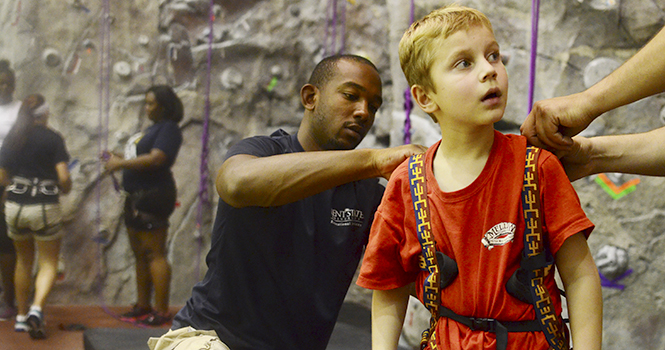Try rock wall climbing at Kent State Recreation Center
Desmond Bates, junior human development and family studies major, helps Emerson Puch, 7, of Hartville, get strapped in to climb the rockwall at the Rec Center on Sept. 14. Photo by Nancy Urchak.
September 17, 2012
The Kent State Student Recreation and Wellness Center’s rock-climbing wall is an alternative form of exercise, which students of all skill levels can enjoy.
“We have something for every skill level,” Outdoor Adventure Coordinator Dave Herpy said. “It’s really all abilities and skill levels from beginners, someone who has never rock climbed before, to the advanced, who come every day and climb the toughest routes.”
For Beginners and Experts
Beginners can use routes that are vertical with big hand and foot holds on which to climb.
Anything inside the cave part of the wall, which includes horizontal climbing, requires more upper-body strength and technique to get out of the cave and up the wall.
“Here at the Rec we have the ability to climb two different ways: lead climb and top-rope climb,” Herpy said.
Lead climb is when a climber starts with the rope at the bottom of the wall and climbs up while clipping to anchor points as he or she climbs. This climb requires more ability and is very technical.
In top-rope climbing, the rope goes from the climber, up and around the anchor then down to the belayer. A belayer is the person in control of the ropes while the other is climbing. Slack then is taken out of the rope as a climber moves up, so he or she won’t fall from a great distance.
Climbing Options
Interested participants have two options when it comes to scaling the climbing wall.
Someone with little to no climbing experience can try out the wall without taking a safety course. A beginner can pay $4 for two climbs. After signing a release form, the participant will have a staff member’s help getting into a harness. The staff member will hold the rope as the climber scales the wall.
Skills needed to pass the safety test
Putting the harness on properly
General safety about climbing
Able to tie self in the rope using a figure eight follow through knot and then a double fisherman’s knot
Show ability of the use of proper belaying commands with belayer
Redundancy check to make sure belayer is clipped in properly and to check for proper knots
Proper belaying techniques
The second option is to get certified and become an approved climber by taking a free safety and skills test.
Herpy offers an introduction to climbing clinic to gain the skill set needed to pass the test.
Michaela Kline, sophomore international relations major and a Rec Center employee, said she has seen a lot of freshmen come in and take the first option, but then come back and decide to become certified.
Logan Baird, freshman aeronautics major, said he chose to become an approved climber so he can learn more about the sport.
“I picked the second option because I wanted to gain more knowledge about climbing,” Baird said. “I am very passionate about climbing and have even climbed up the side of a building, so for my safety I thought getting certified and taking the Introduction to Rock Climbing class was the best fit for me.”
The Rec also offers free try climbs from 4 to 8 p.m. every Friday.
“We want to give people the opportunity to try the wall free of charge,” Herpy said. “If they really like it, we can get them into a clinic on that next Monday or Tuesday. One out of every four people who come in takes the clinic to get certified.”
The Introduction to Rock Climbing clinic is available 6 to 8 p.m. every Monday and Tuesday for $15.
The climbing wall is open 4 to 10 p.m., Monday through Thursday and 4 to 8 p.m. Friday.
Contact Breanna Reffel at [email protected].

























